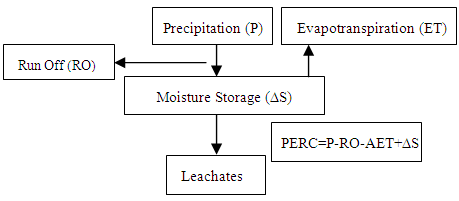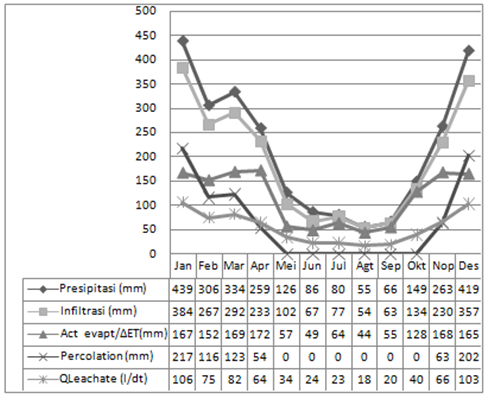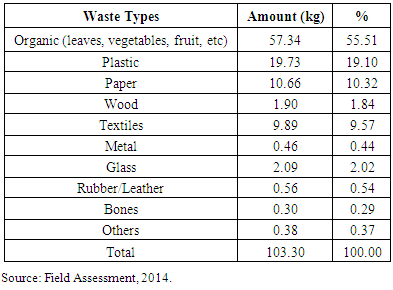-
Paper Information
- Paper Submission
-
Journal Information
- About This Journal
- Editorial Board
- Current Issue
- Archive
- Author Guidelines
- Contact Us
Resources and Environment
p-ISSN: 2163-2618 e-ISSN: 2163-2634
2016; 6(2): 23-27
doi:10.5923/j.re.20160602.01

Landfills Leachates Quality and Quantity in Tidal Area in Banjarmasin Landfills, Indonesia
Irfa’i1, Bagyo Yanuwiadi2, Suyadi2
1Polytechnic of Health Studies, Ministry of Health, Banjarmasin, Indonesia
2Graduate School of Environment Sciences, University of Brawijaya, Malang, Indonesia
Correspondence to: Irfa’i, Polytechnic of Health Studies, Ministry of Health, Banjarmasin, Indonesia.
| Email: |  |
Copyright © 2016 Scientific & Academic Publishing. All Rights Reserved.
This work is licensed under the Creative Commons Attribution International License (CC BY).
http://creativecommons.org/licenses/by/4.0/

The main issue in the perspective expectation of tidal landfill is about the big potential in polluting the environment. One of the pollutants which caused by the landfills is leachates. To prevent the leachates contamination around the environment, it is required to have a landfills leachates and cultivation management. Leachates quality and quantity data is required for the leachates cultivation. The leachates quantity of tidal landfills is determined with the water balance method (Thornthwaite). Leachates discharge which formed in landfills is in the range of 64-106 lt/s on wet months (Nov-April) and 18 - 40lt/s on dry months (May- Sept). The quality of tidal landfills Banjarmasin is based on the TDS, BOD, COD, Fe, NH3N various parameters and there is a decrease of the pollutant concentration in the age of landfill zone of 1 year up to 10 years. The longer the age of the landfill zone, the smaller the leachates pollutant content.
Keywords: Thornthwaite method, Tidal land area, Leachates
Cite this paper: Irfa’i, Bagyo Yanuwiadi, Suyadi, Landfills Leachates Quality and Quantity in Tidal Area in Banjarmasin Landfills, Indonesia, Resources and Environment, Vol. 6 No. 2, 2016, pp. 23-27. doi: 10.5923/j.re.20160602.01.
Article Outline
1. Introduction
- Leachate generated from landfill, is an important source of environmental pollution around the landfill. The increase in municipal waste Banjarmasin reached 1019 m3 per day and is likely to increase from year to year will increase the production of leachate and the more potential to pollute the environment. The presence of leachate from the landfill has a high risk of contaminating water and soil around the landfill [1]. Leachate contains dissolved organic material, inorganic compounds and metals [2]. The dump has been identified as one of the major threats to water resources and land [3].Production of leachate coming from the liquid contents in the trash because of the decomposition process is also involved rain water into the garbage and litter decomposition dissolving material that accumulates at the bottom of the landfill and seeping through the ground [4]. Contamination occurs due to the continuous leachate seeping into the environment from time to time regardless of the environmental consequences [5]. Landfill conditions in the tidal area further increased the potential for leachate contamination of the environment. The existence of leachate at the landfill must be managed and processed so that it does not cause environmental pollution. To perform the processing, it needs accurate data such as quantities and quality of the landfill leachate.The leachates quantity of landfills is determined by the rain intensity, the landfills effective extensive, evaporation, infiltration/soil porosity and the moist level of the waste. While the leachates quality is determined by the waste composition, waste amount, water amount which dissolves the waste as well as the landfills operational system. Leachates quality and quantity is important to be examined in accordance with the leachates management including leachates collection, distribution, cultivation, and extrication to the environment.The tidal condition of the environment affected the leachates amount and dissemination around the landfills environment. Tidal water caused the soil to be water-rich. The existence of tidal condition also affected the underground water flow which tends to be up and down/unstable which caused the leachates dissemination to be evenly spread. The dissemination of leachates could spread on the landfills surrounding area. This study was aimed to assess the quality and quantity of leachates in Basirih Landfill, Banjarmasin.
2. Leachates Assessment
- The leachates which occurred on the operation could be determined by Water Balance Method [6]. This method is based on the assumption that leachates are only produced by rainfall that has successfully infiltrated into the heap of the waste (percolation). Some other sources such as the result of garbage decomposition, infiltration of the surface ground water, and other surface water flow could be ignored. The factors that influence the percolation quantity in Water Balance Method are: Precipitation, Evapotranspiration, Surface run-off, and Soil moisture storage (Figure 1).
 | Figure 1. Input-Output System from the Water Balance [7] |
 | (1) |
 | (2) |
 | (3) |
 | (4) |
 | (5) |
3. Research Method
- The method used in this study is a survey method. The survey was conducted to assess the physical aspects of the landfill as a waste processing infrastructure, assessing the number and characteristics of waste as a source of leachate. The quality of landfill leachate was measured in 1 year, 5 years and 10 years garbage zones. The total amount of leachate samples were 18 samples. Time of sampling is done on the terms of season, i.e. rainy season and dry season. Assessment quality of leachate consisted of the parameter Total Dissolved Solid (TSS), Biological oxygen demand (BOD), Chemical oxygen demand (COD), Iron (Fe), Ammonium (NH3N) and pH. Measurements were also performed on the trash to determine the characteristics of the waste to produce leachate.Leachate quantity measurements performed using water balance [8]. The calculation is done by using rainfall data for 10 consecutive years, e.g. evaporation, percolation and infiltration (the physical condition of the ground). Besides, the necessary data for the calculation of leachate quantity is the water content in the garbage and the amount of organic waste. Additional supporting data used in the calculation of the quantity of leachate is temperature and humidity. Landfills study area currently 39.5 hectares with an active area of the landfill 20 hectares, divided into 16 zones hoarding.The collected data was in the form of primary and secondary data. Primary data were obtained from a direct interview with the Landfills manager, leachates water quality and quantity measurement and an interview with other relevant institution or agency. In the implementation of primary data collection, there was a direct field observation of the investigated variable through sampling which was conducted with standards and basic procedures. Secondary data was collected from Cleaning and Landscaping Department of Banjarmasin (Dinas Kebersihan dan Pertamanan Kota Banjarmasin), Environmental Department of Banjarmasin (Badan Lingkungan Hidup Kota Banjarmasin), BAPPEDA Banjarmasin, Kimpraswil Agency Banjarmasin, Climatology and Geophysics Station and other parties that relevant to the research plan. Primary or secondary data was analysed and formulated in order to determine the quantity and quality of the tidal landfill leachates.
4. Results and Discussion
4.1. Leachates Quantity
- The leachates quantity which produced by Banjarmasin landfills is fluctuated depending on the precipitation of that area, the landfill extensive area and the waste water amount which entered the landfill. The average waste amount which entered the Landfills is 512 tons/days (Hygiene Department, Banjarmasin). The precipitation data was based on observation during the last ten years on 2003-2012. Figures rainfall ranges from 55 - 439 mm which is divided in 6 wet months and 6 dry months. Infiltration that occurs in the landfill area ranging from 54 mm 384 mm. Evaporation at landfill sites ranged from 44 mm to 167 mm. While the numbers percolation is very low ranges from 0 mm to 217 mm. Low percolation was caused by the tidal soil conditions. Discharge leachate is formed, ranging from 64-106 l/sec in wet and 18-40lt / sec in the dry months. The leachate formed trend can be seen in Figure 2.
 | Figure 2. Leachates Quantity on Banjarmasin Landfills (Source: Data Analysis) |
4.2. Leachates Quality
- The quality of leachates in the landfill is influenced with the waste composition, waste amount, rain intensity as well as the duration of the waste heap. After the test box sampling was conducted, the soil composition of Banjarmasin Landfill is in accordance with the SNI 19-3964-1994 and the results are as follows (Table 1). The waste composition of Banjarmasin Landfills is dominated by organic waste of 55.5%, plastic waste of 19.1% and the rest are paper, textiles, glass, wood, metal, rubber, bones, etc. This waste composition will affect the formation of leachates quality. These results are lower than in Jakarta, which are 64.07% of organic waste, while the inorganic waste which is dominated with paper waste of 15.97% and plastic waste of 14.83% [11]. Haitian city, Haiti has 65% of organic waste [12]. Chittagong Bangladesh has 62% of organic waste [13]. Based on that waste composition, the leachates concentration will also be dominated by organic biodegradable content and the rest is non biodegradable content which influenced the Landfills leachates quality. After the implementation of sampling and laboratory test, Banjarmasin Landfills leachates have the quality as follows (Table 2).
|
|
5. Conclusions
- Debit landfill leachate formed in Banjarmasin is averaged of 55 lt/sec. For the wet months (Nov - April) ranges from 64-106 lt/sec, while the dry season (May - Sept), between 18 – 40 lt/sec. The dominant factors which affected the leachates debit is the rain intensity (precipitation). Infiltration factor in tidal landfill area is very small due to the condition that the soil is very high saturated water and the flow that tends to be stagnant.Banjarmasin landfill leachate quality parameters based on total dissolved solid (TDS) of 8,108 mg/lt at the age of landfill 1 year, 1,626 mg/lt at the age of landfill 5 year and 1,263 mg/lt at the age of 10 year landfill. Biological oxygen demand (BOD), 423 mg/lt at the age of landfill 1 year, 127 mg/lt at the age of landfill 5 year and 62 mg/lt at the age of 10 year landfill. Chemical oxygen demand (COD) of 6,518 mg/lt at the age of landfill 1 year, 1,138 mg/lt at the age of landfill 5 year and 585 mg/lt at the age of 10 year landfill. Iron (Fe) of 141 mg/l at the age of landfill 1 year, 78 mg/lt at the age of landfill 5 year and 80 mg/lt at the age of landfills 10 year. Ammonium (NH3N) of 257 mg/lt at the age of landfill 1 year, 129 mg/lt at the age of landfill 5 year and 125 mg/lt at the age of 10 year landfill. Pollutant concentrations varied and decrease pollutants at the age of landfill zone 1th to 10th. This condition is based on the time processing of waste decomposition on the landfill area. We suggest to observe and examine the influence of leachates pollutants in Landfills towards the surrounding area and the socio-economic community on the subsequent research.
ACKNOWLEDGEMENTS
- We present a thank you for the Director of Health Polytechnic for the funding support in the implementation of learning assignment as well as the other parties which help the research.
 Abstract
Abstract Reference
Reference Full-Text PDF
Full-Text PDF Full-text HTML
Full-text HTML
